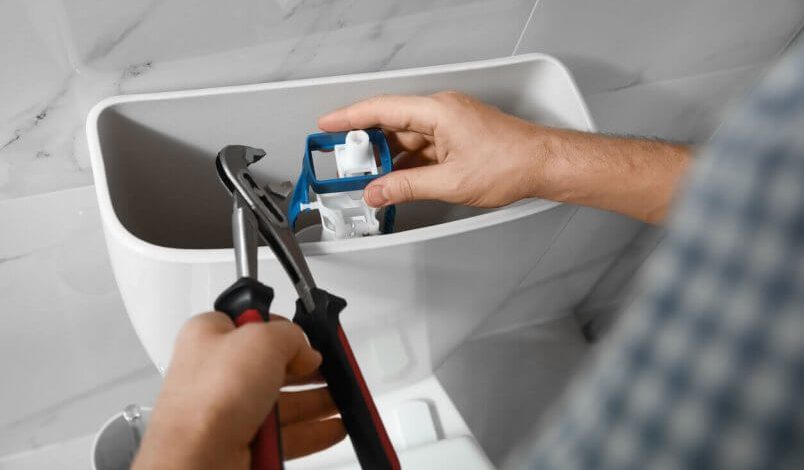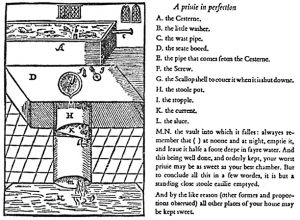Make sure the water supply valve is fully open. Next, inspect the fill valve for any debris or signs of wear. Set the float correctly to restore efficient tank refilling.
These are the most common steps recommended for fixing a slow-filling toilet tank, but is it really that simple?
The truth is, most homeowners don’t enjoy getting their hands dirty inside a toilet tank, which is why calling a plumber becomes the practical choice.
Here is a look at some of the common reasons for toilets not filling properly and how a plumber might go about fixing it.
Key takeaways:
- Use a screwdriver to lift the float on older toilets. For newer models, adjust the knob by hand. Set the water level about 2 cm below the overflow tube.
- Mineral buildup and rust inside the valve can restrict flow. Valve damage adds to the slowdown in water supply.
- Unscrew the fill valve cap and flush it to clear debris. Use a bottle brush to clean out buildup in the valve tube.
Issues That Might Be Slowing Down Your Toilet Tank

1. A Problem with the Water Supply Valve
The water supply valve controls how much water flows into your toilet tank after each flush. If the valve isn’t fully open or becomes partially blocked, it restricts the flow and slows down the refill process.
Mineral deposits, rust, or debris can build up inside the valve. The valve itself may wear out and this leads to a slower water supply.
2. Water-Filled Float Ball
The float ball rises with the water level and signals the fill valve to stop once the tank is full. When the float ball becomes waterlogged, it can’t rise properly, causing the valve to shut off too early. As a result, the tank doesn’t fill to its full capacity and may take longer to refill.
3. Problems with the fill valve tube
The fill valve tube directs water into the overflow tube and refills the toilet bowl after each flush.
A disconnected or misaligned tube prevents proper water flow and slows or disrupts the refilling process.
In some cases, the tube may also become clogged with mineral buildup. When this happens, the tank may not fill to the correct level.
How to Fix a Slow-Filling Toilet? Inspection, Fixing, & Maintenance
Before jumping into repairs, inspect each part of the tank to find the real cause of the slow refill. Fixing a slow-filling toilet begins with a proper inspection, followed by targeted repairs and regular maintenance.
Keep in mind that DIY fixes might save you some cash upfront, but hiring a plumber can save you even more in the long run.
Inspection
- Check the water supply valve – Valve is only partially open or difficult to turn.
- Inspect the float ball – The float sits too low, doesn’t rise with the water, or appears waterlogged.
- Check fill valve & connections – Loose fittings, signs of corrosion, or visible wear.
- Examine the fill valve tube – Tube is disconnected, misaligned, kinked, or clogged.
- Check for mineral buildup or debris – Visible gunk around valve components.
Fixing
- On older toilets, use a screwdriver to raise the float. On newer models, turn the adjustment knob by hand.
- Aim for the water level to sit about 2 cm below the overflow tube.
- Inspect and replace the float ball if it’s waterlogged. Bend the float arm upward to allow more water in.
- Replace the float ball if it no longer floats properly. Consider upgrading to a newer float system if needed.
- Reconnect or replace the valve tube if it’s misaligned or damaged.
- Replace the tube if it’s brittle, cracked, or clogged beyond repair.
Cleaning
- Clean the fill valve by unscrewing the cap and flushing out debris with water.
- Clean the valve tube using a bottle brush or small wire brush to remove buildup.
- Open and close the supply valve a few times to flush out any remaining sediment.
- Reassemble all parts and turn the water supply back on.
- Check for improved refill speed after cleaning is complete.
Verified Plumbers Backed by Real Experience
When all else fails, don’t hesitate—just search for “best plumbers near me.” Here at Best Plumbers Club, our network of verified plumbers can help you with all your toilet plumbing issues.
We get it. Finding a reliable plumber can feel like a gamble. That’s why we only connect you with trusted pros who are backed by real experience, verified by a Level 5 Google Local Guide. We know dealing with repairs can be overwhelming—send us a message and we’ll step in to help.
Frequently Asked Questions
Should I replace or clean the toilet fill valve to fix a slow refill?
Plumbers attempt this first by shutting off the water supply, removing the fill valve cap, and flushing out any sediment. They may also clean or replace the washer inside the cap. If cleaning doesn’t restore proper function, replacing the fill valve is usually the next step.
Replacement Cost:
- DIY Replacement: ~$15 to $30 AUD for a standard fill valve kit.
- Plumber Service Call: ~$120 to $230 AUD total, including parts and labor.
Why is my toilet filling up so slow?
Common reasons include a partially closed water supply valve, a clogged or worn-out fill valve, a waterlogged float, or mineral buildup in the valve tube.
How to fix a slow filling toilet tank?
Fully open the water supply valve, clean or replace the fill valve, adjust the float, and clear any buildup in the valve tube.







